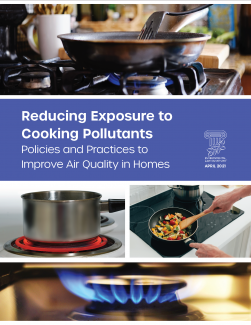
Cooking in a home kitchen produces air pollutants such as particulate matter and nitrogen dioxide that are linked to respiratory problems, cardiovascular disease, cancer, and other adverse health effects. People who are at greater risk of harm from exposure to these pollutants include children, older adults, people with certain underlying medical conditions, and people who have been socially or economically disadvantaged.
There are ways to address these common indoor exposures, starting with ventilation. Kitchen ventilation systems (e.g., vented range hoods) can effectively remove cooking-related pollutants at or near their source. Though the installation of new gas appliances will likely decrease in the coming years, proper ventilation remains important not only for the gas appliances still used in existing homes, but for electric cooking appliances as well.
Many people remain unaware of the problem of cooking pollutants, and new homes are still being built without adequate kitchen ventilation. Thus, many states, localities, and tribes can benefit from stronger policies and programs to improve ventilation and reduce exposure to air pollutants from cooking.
Overview of the Report
This report describes building codes and other policies that states and other jurisdictions can develop to ensure new and renovated homes have adequate kitchen ventilation. The report also notes opportunities to improve kitchen ventilation and reduce exposure in existing homes by improving housing codes and leveraging funding programs to assist families that need financial assistance.
Building Codes. To improve kitchen ventilation in building codes, policy makers can (1) require the installation of kitchen exhaust ventilation systems in all new residential construction (state and model codes typically do not); and (2) establish minimum ventilation performance standards to ensure that exhaust systems can remove a sufficient share of the pollutants emitted during cooking immediately after they are emitted. This might include more stringent standards for kitchens with gas stoves.
Green Building Laws. Many jurisdictions have laws establishing green building standards for certain types of construction such as affordable housing developments. These green building policies present an important opportunity to protect health at the same time they are promoting energy and other resource conservation strategies. Policymakers can make sure that the green building criteria they adopt incorporate kitchen ventilation best practices.
Housing Codes. Reducing cooking pollutant exposure in existing homes is no less important than in new construction. Housing codes and landlord-tenant laws are common policy tools for establishing minimum property maintenance standards. These policies typically have general ventilation requirements that could potentially be applied to ensure adequate kitchen ventilation. They may also require maintenance of equipment, which could be used to address malfunctioning kitchen ventilation. Jurisdictions can strengthen their housing codes to include more specific kitchen ventilation standards, and they can incorporate kitchen ventilation provisions into inspection forms and other code enforcement practice documents.
Funding Programs. A variety of financial and material assistance programs have been established to help households retrofit or repair existing homes. These programs can be leveraged to help accelerate kitchen ventilation improvements in affordable rental properties and for homeowners with limited incomes. Weatherization and energy retrofits play a prominent role in climate policies and represent an important opportunity for improving kitchen ventilation for lower-income families. Healthy homes and asthma programs that provide in-home assessments, education about behavior change, and/or modifications to the home are another potential source of funding to reduce exposures.
In addition to these policy tools, jurisdictions can develop and communicate information on both the health risks from cooking pollutants and the solutions that are available. Many people are not aware of these risks or of the ventilation practices and cooking techniques that can significantly reduce exposure.
Explore other materials from ELI’s Indoor Environments Program.
© Environmental Law Institute®